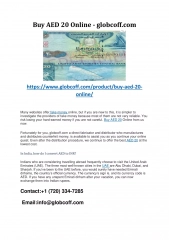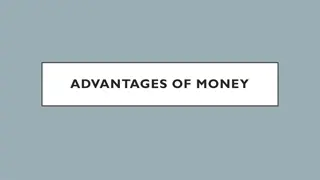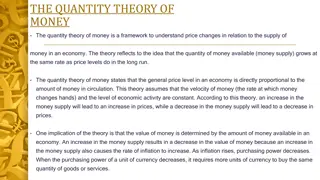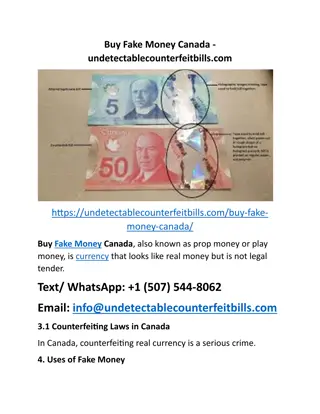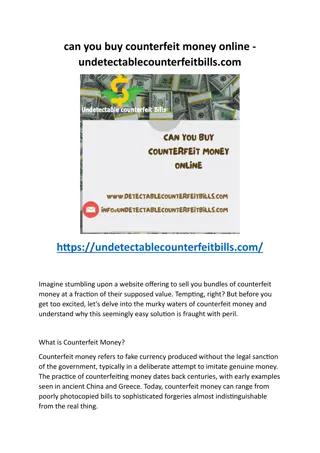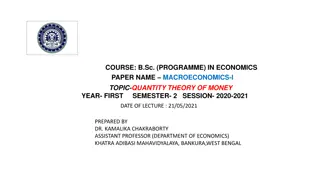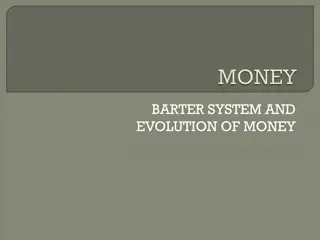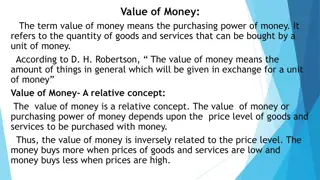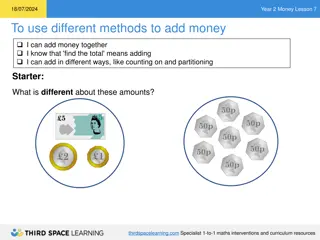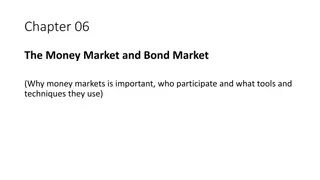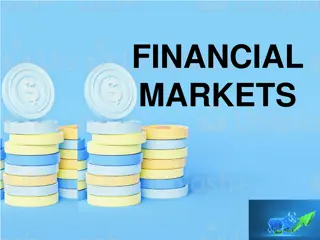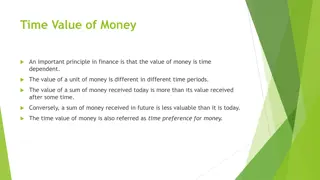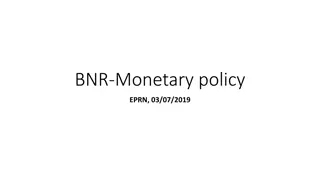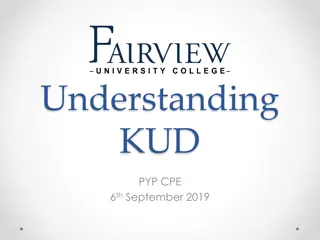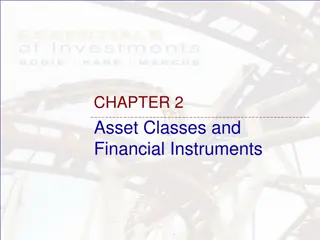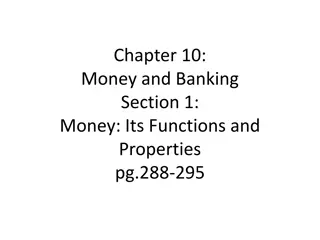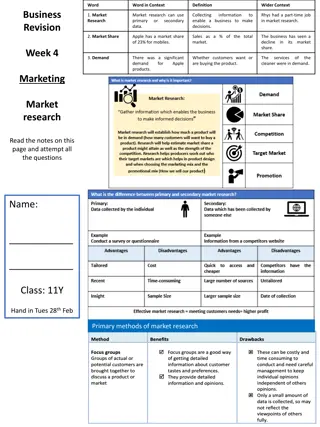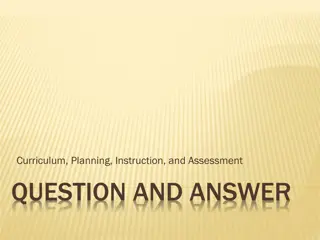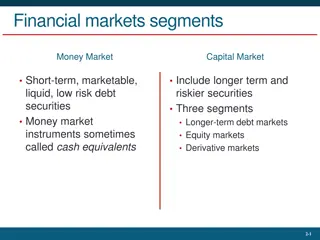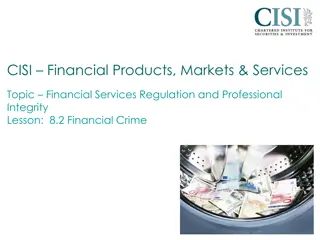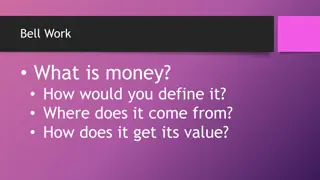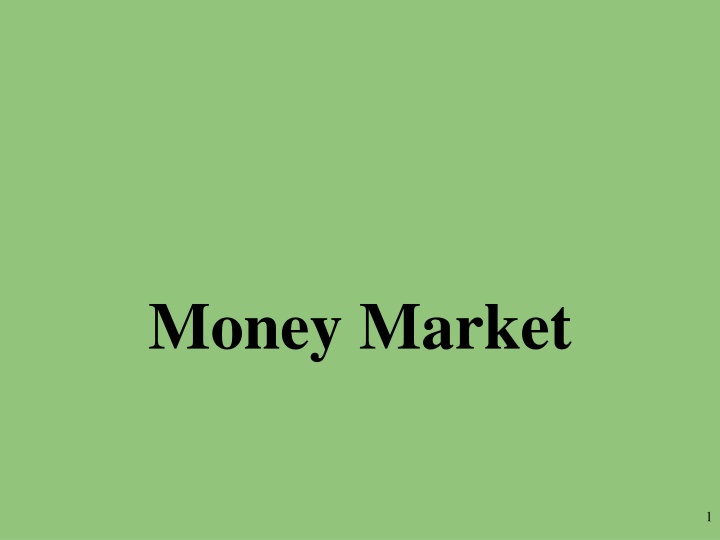
Money Market: Demand, Supply, and Monetary Policy
Explore the dynamics of the money market, including the demand for money, the relationship with interest rates, and the influence of the Federal Reserve's monetary policy. Learn about the factors affecting money demand and supply, and how they impact the economy. Dive into key concepts such as transaction demand, asset demand, interest rate effects, and the role of the Federal Reserve in shaping the money supply.
Download Presentation

Please find below an Image/Link to download the presentation.
The content on the website is provided AS IS for your information and personal use only. It may not be sold, licensed, or shared on other websites without obtaining consent from the author. If you encounter any issues during the download, it is possible that the publisher has removed the file from their server.
You are allowed to download the files provided on this website for personal or commercial use, subject to the condition that they are used lawfully. All files are the property of their respective owners.
The content on the website is provided AS IS for your information and personal use only. It may not be sold, licensed, or shared on other websites without obtaining consent from the author.
E N D
Presentation Transcript
The Money Market (Supply and Demand for Money) 3
The Demand for Money At any given time, people demand a certain amount of liquid assets (money) for two different reasons: 1.Transaction Demand for Money- People hold money for everyday transactions. 2.Asset Demand for Money - People hold money since it is less risky than other assets What is the opportunity cost of hold keeping money in your pocket or checking account? The interest you could be earning from other financial assets like stocks, bonds, and real estate 4
The Demand for Money 1. What happens to the quantity demanded of money when interest rates increase? Quantity demanded falls because individuals would prefer to have interest earning assets instead 2. What happens to the quantity demanded when interest rates decrease? Quantity demanded increases. There is no incentive to convert cash into interest earning assets There is a inverse relationship between the interest rate and the quantity of money demanded 5
The Demand for Money Inverse relationship between interest rates and the quantity of money demanded Nominal Interest Rate (ir) 20% 5% 2% MD 0 Quantity of Money (billions of dollars) 6
The Demand for Money What happens if price level increase? Money Demand Shifters 1. Changes in price level 2. Changes in income 3. Changes in technology Nominal Interest Rate (ir) 20% 5% MD1 2% MD 0 Quantity of Money (billions of dollars) 7
The Supply for Money The U.S. Money Supply is set by the Board of Governors of the Federal Reserve System (FED) Interest Rate (ir) The FED is a nonpartisan government office that sets and adjusts the money supply to adjust the economy This is called Monetary Policy. MS 20% 5% 2% MD Quantity of Money (billions of dollars) 200 9
The Federal Reserve What is the Fed? Transcript (PDF): http://www.federalreserve.gov/mediacenter/files/what-is-the-fed-transcript-2016.pdf Learn more: http://www.federalreserve.gov/aboutthefed/structure-federal-reserve-system.htm 10
Increasing the Money Supply MS Rate (ir) MS1 Interest If the FED increases the money supply, a temporary surplus of money will occur at 5% interest. The surplus will cause the interest rate to fall to 2% 10% 5% 2% MD 250 200 Quantity of Money (billions of dollars) 11
Decreasing the Money Supply MS Rate (ir) MS1 Interest If the FED decreases the money supply, a temporary shortage of money will occur at 5% interest. The shortage will cause the interest rate to rise to 10% 10% 5% 2% MD 150 200 Quantity of Money (billions of dollars) 12
Wait, why would the FED ever want to slow down the economy? To fight inflation The role of the Fed is to take away the punch bowl just as the party gets going 13
How the FED Stabilizes the Economy These are the three Shifters of Money Supply 15
3 Shifters of Money Supply 16
3 Shifters of Money Supply The FED adjusts the money supply by changing any one of the following: 1. Setting Reserve Requirements (Ratios) 2. Lending Money to Banks & Thrifts Discount Rate 3. Open Market Operations Buying and selling Bonds The FED is now chaired by Jerome Powell 17
#1. The Reserve Requirement If you have a bank account, where is your money? Only a small percent of your money is held in reserve. The rest of your money has been loaned out. This is called Fractional Reserve Banking The FED sets the amount that banks must hold The reserve requirement (reserve ratio) is the percent of deposits that banks must hold in reserve (the percent they can NOT loan out) When the FED increases the money supply it increases the amount of money held in bank deposits. As banks keeps some of the money in reserve and loans out their excess reserves The loan eventually becomes deposits for another bank that will loan out their excess reserves. 18
#2. The Discount Rate The Discount Rate is the interest rate that the FED charges commercial banks. Example: If Banks of America needs $10 million, they borrow it from the U.S. Treasury (which the FED controls) but they must pay it back with 3% interest. To increase the Money supply, the FED should _________ the Discount Rate (Easy Money Policy). To decrease the Money supply, the FED should _________ the Discount Rate (Tight Money Policy). INCREASE DECREASE 19
#3. Open Market Operations Open Market Operations is when the FED buys or sells government bonds (securities). This is the most important and widely used monetary policy To increase the Money supply, the FED should _________ government securities. To decrease the Money supply, the FED should _________ government securities. BUY SELL How are you going to remember? Buy-BIG- Buying bonds increases money supply Sell-SMALL- Selling bonds decreases money supply 20
Exit Ticket 3-2-1 Write 3 things that you now know about the money market. Write 2 questions you have Draw 1 correctly labeled money market graph.

